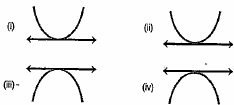A quadratic equation has double root, then
the two roots lie on the different sides of the axis
the quadratic equation cannot be expressed in the form of a perfect square.
the product of the roots is always negative.
the sum of the roots may be positive or negative.
The correct Answer is:D
Step by step video, text & image solution for A quadratic equation has double root, then by Maths experts to help you in doubts & scoring excellent marks in Class 14 exams.
Updated on:21/07/2023Topper's Solved these Questions
Similar Questions
Knowledge Check
Which one(s) of the following graphs is/are correctly sketched for the given quadratic equation which has double root (i.e., both the roots are equal), considering that all of these graphs appear considerably thick when seen, with a magnifying lens? The horizontal lines, in these graphs, represent the X-axis.
 A(A) (i) and (ii)B(B) (ii) and (iv)C(C) (i) and (iii)D(D) (ii) and (iii)
A(A) (i) and (ii)B(B) (ii) and (iv)C(C) (i) and (iii)D(D) (ii) and (iii)p : Every quadratic equation has one real root and q Every quadratic equation has two real roots, then truth value of p and q are:
Ap is true and q is falseBp is false and q is trueCp and q both trueDp and g both falseIf a quadratic equation has one real root then the other root will necessarily be
ArealBequalCcomplex conjugateDrational and unequal
What can be the correct possible set of factors that determines the location of roots of ax2+bx+c=0 of a quadratic equation which has a double root with respect to a randomly chosen point /con the X-axis?
View SolutionWhich of the following quadratic equations has real roots ?
View SolutionWhich of the following quadratic equations has real roots ?
View SolutionWhich of the followig quadratic equations has real roots ?
View SolutionWhich of the following quadratic equations has real roots ?
View Solution
